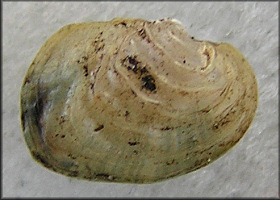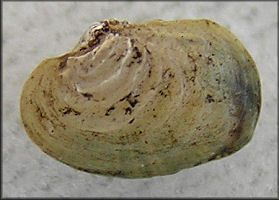| Musings On A Local Specimen Of Toxolasma paulum (I. Lea, 1840), The Iridescent Lilliput | |
| By Harry G. Lee | |
|
|
|
| Attached to leaf dredged from the bottom of Big Davis Creek (tributary of Julington Creek) adjacent to U. S. Route 1 just north of Bayard, southeastern Duval County, Florida. Collected by Bill Frank, 3/11/2006. Six millimeters. | |
|
Identifying tiny clams can be a difficult proposition for even
the most experienced collector, and freshwater species are no
exception. Although small enough to be an adult Pea Clam, Fingernail
Clam, or even a Corbicula, the non-commarginal (not parallel
to growth lines) rugged beak sculpture manifest only on the umbones
on this specimen is unique to the superfamily Unionoidea, or pearly
freshwater mussels. These are the species known to occur in the four
Northeast Florida counties: Anodonta couperiana I. Lea, 1840 Barrel Floater Elliptio ahenea (I. Lea, 1847) Southern Lance Elliptio jayensis (I. Lea, 1838) Florida Spike Elliptio crassidens (Lamarck, 1819) Elephant Ear Elliptio monroensis (I. Lea, 1843) St. John's Elephant-ear Elliptio occulta (I. Lea, 1843) Hidden Spike Elliptio waltoni (B. H. Wright, 1888) Florida Lance Toxolasma paulum (I. Lea, 1840) Iridescent Lilliput Uniomerus carolinianus (Bosc, 1801) Florida Pondhorn Villosa amygdalum (I. Lea, 1843) Florida Rainbow Villosa vibex (Conrad, 1834) Southern Rainbow Villosa villosa (B. H. Wright, 1898) Downy Rainbow Utterbackia imbecillis (Say, 1829) Paper Pondshell [non-indigenous] Based on the "single loop" pattern, the following can be ruled out Villosa amygdalum (I. Lea, 1843) Florida Rainbow Villosa vibex (Conrad, 1834) Southern Rainbow Villosa villosa (B. H. Wright, 1898) Downy Rainbow Leaving: Anodonta couperiana I. Lea, 1840 Barrel Floater Elliptio ahenea (I. Lea, 1847) Southern Lance Elliptio jayensis (I. Lea, 1838) Florida Spike Elliptio crassidens (Lamarck, 1819) Elephant Ear Elliptio monroensis (I. Lea, 1843) St. John's Elephant-ear Elliptio occulta (I. Lea, 1843) Hidden Spike Elliptio waltoni (B. H. Wright, 1888) Florida Lance Uniomerus carolinianus (Bosc, 1801) Florida Pondhorn Toxolasma paulum (I. Lea, 1840) Iridescent Lilliput Utterbackia imbecillis (Say, 1829) Paper Pondshell Of these the shell outline, which can change somewhat with growth (allometry), is only consistent with two species: Uniomerus carolinianus (Bosc, 1801) Florida Pondhorn Toxolasma paulum (I. Lea, 1840) Iridescent Lilliput The habitat is much more consistent with U. carolinianus, which, unlike the Iridescent Lilliput, has been taken in Duval Co., so I examined my adult specimens. Unfortunately, even though they are grand shells, they are eroded at the beaks, and no sculpture is apparent. Thence I went to my library and, after some disappointing false starts, found Johnson (1972). He reported that the beak sculpture of this species consists of " five or six heavy ridges that form a rounded angle on the posterior ridge ..." The juvenile shell's posterior is characterized in very precise lingo (for us musselheads), and it essentially rules out this species. Next I read Johnson's description of the beak sculpture of the Iridescent Lilliput. He reported "several ridges parallel to growth lines," which struck me as (1) not what our shell showed (noncom-, as opposed to commarginal) and (2) inconsistent with my accumulated conchological observations on various species and the few illustrations of unionoidean beak sculpture I had seen. What to do? Tempted to throw up my hands, I nevertheless went back to the collection and pulled my Iridescent Lilliputs. They have well-preserved beak sculpture! Not only that, the early shell is identical to the specimen in question. The faint rays on the specimen help confirm the Toxolasma paulum diagnosis - as does the bluish suffusion on the posterior region. While this species has not previously been documented from Duval County, it has been found in sixteen stations in the St. Johns River system - of which this creek is a part.
Knowing that “paulus –a –um” was an adjective meaning
small, I felt the specter of my high school Latin teacher, Mrs.
Ewing, looking over my shoulder. Expecting gender agreement between
genus and adjectival species names, I had winced countless times
when confronted with the binomen "Toxolasma paulus" as it
appears in the vast majority of modern publications on naiads (e. g.,
Turgeon, Quinn, et al., 1998). My presumption was, since the word
ended in an "a," that genus name was likely a feminine noun
consistent with Mrs. Ewing's rule regarding "a" terminations.
I also recalled that a substitute Latin I teacher, Mr. Cornish,
shared a mnemonic "L-A-N-C-E-T" for the terminations of irregular
neuter nouns. Further confused by the fact that certain "-a"
nouns of the first declension, e.g., agricola (farmer),
nauta (sailor), were masculine, I realized that the wincing may
have been unnecessary. If I was going to be certain, the only
recourse was in a little research, which I began three years ago. Feeling the need for more gender-evidence,
and realizing I hadn't exploited my electronic resources, on May 1,
2006 I
Googled the more
frequently-cited, but equally gender-bent, congener, Toxolasma
parvus, (process and results
underlined)! It was a
bit like a slot-machine jackpot; there was an expected deluge
(hits): Toxolasma parvum
(35), Toxolasma parva (115), and
Toxolasma parvus (353). So there was still discord in
gender, and the (still incongruous) masculine proponents were in the
lead. Impelled to push this electronic campaign, I went the work of
Gary Rosenberg, who has a scientific name gender dictionary at his
Malacolog database at the Academy of Natural Sciences of
Philadelphia (ANSP - and coincidentally home to some of Rafinesque's
collection). There I got no hits with a "*lasma" inquiry. Next I
went to the ANSP Indo-Pacific database, which produced three genera,
which I then Googled.
Incorporating primary, secondary, tertiary, and
quaternary generations of searches, and pretty-much limiting my report to
unambiguous adjectival species-level epithets, I got: I think the case for neutering Toxolasma Rafinesque, 1831 is now powerful enough impel a rewrite on my labels. Let it be Toxolasma parvum (Barnes, 1823) and T. paulum (I. Lea, 1840) - hopefully putting an end to a Blefuscuan palaver over the Lilliputs, an apt name for the genus containing the very smallest naiads on Earth. ** In this analysis there are several instances which demonstrate malacology to be, like all of science, a dynamic, self-correcting process, one which is built on the labors of our worthy predecessors, yet, through new discoveries, borrowed disciplines, and plain curiosity, inexorably advances - more often than not in unanticipated directions. Among the lessons learned in such a travail is to avoid reliance on any "fact," in the literature or on the Internet, unless it is accompanied by compelling evidence. Googling is like riding a locomotive, you go fast and can get almost anywhere, but you'd better be certain you have the right ticket lest you get off-track and debark at the wrong station.
Binney, W. G. and G. W. Tryon, Jr., 1864. The complete writings of
Constantine Smaltz [sic] Rafinesque on Recent and
fossil conchology. Bailliere Bros., New York. pp. 1-96 + index pp.
1-6 + pls. lxx-lxxii. [see Rafinesque; a facsimile was published in
1984]. Appendix: These are the species of Toxolasma parsed according to the new gender analysis: T. corvunculus (noun in apposition; no change from current usage)T. cyllindrellus (noun in apposition; no change from current usage) T. lividum T. mearnsi (genitive; no change from current usage) T. parvum T. paulum T. pullus (noun in apposition; no change from current usage) T. texasense **Epilogue: Completing the loop two and a half months after Bill's find, Dr. Patrick Baker of the Institute for Food and Agricultural Studies, University of Florida collected near Bill's find and took several inch-long adult animals for the first time in Duval Co. See: http://www.jaxshells.org/parvumg.htm |
|

